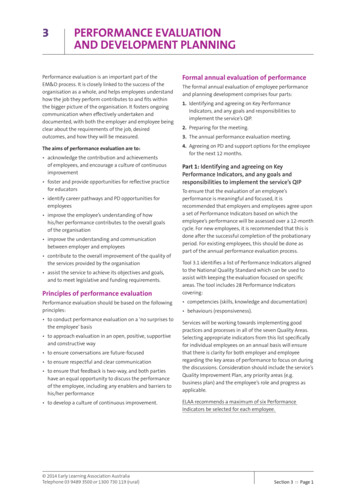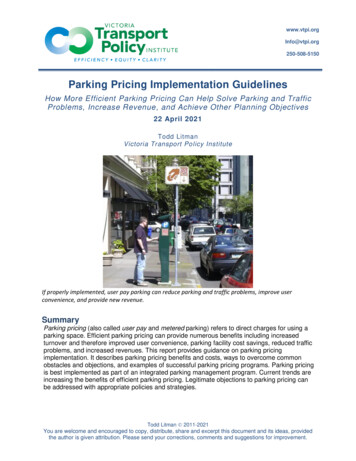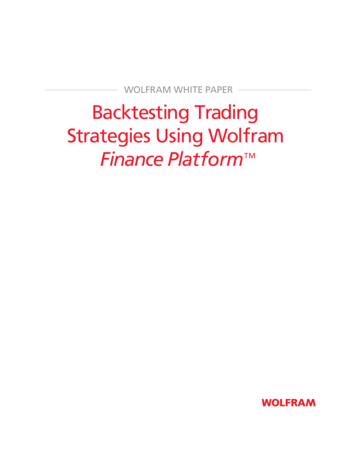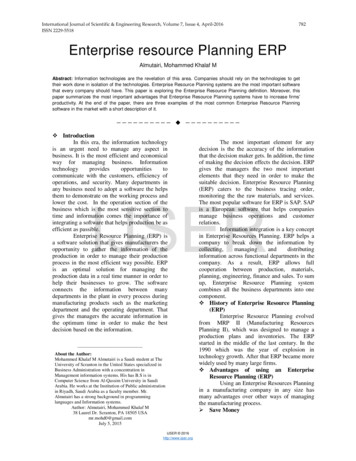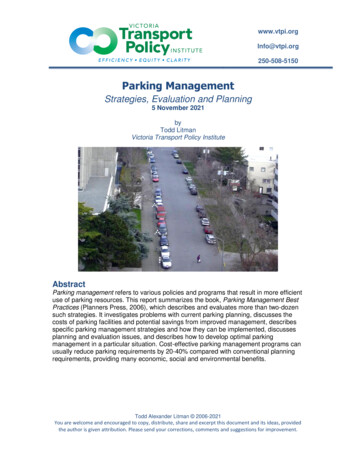
Transcription
www.vtpi.orgInfo@vtpi.org250-508-5150Parking ManagementStrategies, Evaluation and Planning5 November 2021byTodd LitmanVictoria Transport Policy InstituteAbstractParking management refers to various policies and programs that result in more efficientuse of parking resources. This report summarizes the book, Parking Management BestPractices (Planners Press, 2006), which describes and evaluates more than two-dozensuch strategies. It investigates problems with current parking planning, discusses thecosts of parking facilities and potential savings from improved management, describesspecific parking management strategies and how they can be implemented, discussesplanning and evaluation issues, and describes how to develop optimal parkingmanagement in a particular situation. Cost-effective parking management programs canusually reduce parking requirements by 20-40% compared with conventional planningrequirements, providing many economic, social and environmental benefits.Todd Alexander Litman 2006-2021You are welcome and encouraged to copy, distribute, share and excerpt this document and its ideas, providedthe author is given attribution. Please send your corrections, comments and suggestions for improvement.
Parking Management: Strategies, Evaluation and PlanningVictoria Transport Policy InstituteContentsIntroduction . 2Examples . 4Paradigm Shift . 7How Much Is Optimal? . 9Alternative Ways To Determine How Much Parking To Supply . 10Parking Facility Costs . 11Parking Management Strategies . 12Shared Parking. 12Parking Regulation . 13More Accurate and Flexible Standards . 14Reduce Residential Street Width Requirements . 15Parking Maximums . 15Remote Parking and Shuttle Service . 15Smart Growth . 16Walking and Cycling Improvements . 16Increase Capacity of Existing Parking Facilities . 17Mobility Management . 18Parking Pricing . 19Improve Parking Pricing Methods . 19Financial Incentives . 20Unbundle Parking . 20Parking Tax Reform . 21Bicycle Parking and Changing Facilities . 21Improve User Information and Marketing . 21Improve Enforcement and Control . 21Transportation Management Associations and Parking Brokerage . 21Overflow Parking Plans . 21Address Spillover Problems . 21Improve Parking Facility Design and Operation . 22Summary . 23Developing An Integrated Parking Plan . 25Conclusions . 26References And Resources For More Information . 271
Parking Management: Strategies, Evaluation and PlanningVictoria Transport Policy InstituteIntroductionParking is an essential component of the transportation system. Vehicles must park at everydestination. A typical automobile is parked 23 hours each day, and uses several parking spaceseach week. Parking convenience affects the ease of reaching destinations and therefore affectsoverall accessibility.Parking facilities are a major cost to society, and parking conflicts are among the most commonproblems facing designers, operators, planners and other officials. Such problems can be oftendefined either in terms of supply (too few spaces are available, somebody must build more) or interms of management (available facilities are used inefficiently and should be better managed).Management solutions tend to be better than expanding supply because they support morestrategic planning objectives: Reduced development costs and increased affordability.More compact, multi-modal community planning (smart growth).Encourage use of alternative modes and reduce motor vehicle use (thereby reducing trafficcongestion, accidents and pollution).Improved user options and quality of service, particularly for non-drivers.Improved design flexibility, creating more functional and attractive communities.Ability to accommodate new uses and respond to new demands.Reduced impervious surface and related environmental and aesthetic benefits.Parking management refers to policies and programs that result in more efficient use of parkingresources. Parking management includes several specific strategies; nearly two dozen aredescribed in this report. When appropriately applied parking management can significantlyreduce the number of parking spaces required in a particular situation, providing a variety ofeconomic, social and environmental benefits. When all impacts are considered, improvedmanagement is often the best solution to parking problems.Parking Management PrinciplesThese ten general principles can help guide planning decision to support parking management.1. Consumer choice. People should have viable parking and travel options.2. User information. Motorists should have information on their parking and travel options.3. Sharing. Parking facilities should serve multiple users and destinations.4. Efficient utilization. Parking facilities should be sized and managed so spaces are frequently occupied.5. Flexibility. Parking plans should accommodate uncertainty and change.6. Prioritization. The most desirable spaces should be managed to favor higher-priority uses.7. Pricing. As much as possible, users should pay directly for the parking facilities they use.8. Peak management. Special efforts should be made to deal with peak-demand.9. Quality vs. quantity. Parking facility quality should be considered as important as quantity, includingaesthetics, security, accessibility and user information.10. Comprehensive analysis. All significant costs and benefits should be considered in parking planning.2
Parking Management: Strategies, Evaluation and PlanningVictoria Transport Policy InstituteParking Management Benefits Facility cost savings. Reduces costs to governments, businesses, developers and consumers. Improved quality of service. Many strategies improve user quality of service by providing betterinformation, increasing consumer options, reducing congestion and creating more attractive facilities. More flexible facility location and design. Parking management gives architects, designers and plannersmore ways to address parking requirements. Revenue generation. Some management strategies generate revenues that can fund parking facilities,transportation improvements, or other important projects. Reduces land consumption. Parking management can reduce land requirements and so helps topreserve greenspace and other valuable ecological, historic and cultural resources. Supports mobility management. Parking management is an important component of efforts toencourage more efficient transportation patterns, which helps reduce problems such as trafficcongestion, roadway costs, pollution emissions, energy consumption and traffic accidents. Supports Smart Growth. Parking management helps create more accessible and efficient land usepatterns, and support other land use planning objectives. Improved walkability. By allowing more clustered development and buildings located closer tosidewalks and streets, parking management helps create more walkable communities. Supports transit. Parking management supports transit oriented development and transit use. Reduced stormwater management costs, water pollution and heat island effects. Parking managementcan reduce total pavement area and incorporate design features such as landscaping and shading thatreduce stormwater flow, water pollution and solar heat gain. Supports equity objectives. Management strategies can reduce the need for parking subsidies, improvetravel options for non-drivers, provide financial savings to lower-income households, and increasehousing affordability. More livable communities. Parking management can help create more attractive and efficient urbanenvironments by reducing total paved areas, allowing more flexible building design, increasingwalkability and improving parking facility design.This report describes various parking management strategies, how to evaluate these strategiesand develop an integrated parking plan, plus examples and resources for more information.Most parking management strategies have been described in previous publications but noexisting document describes them all or provides guidance on planning and implementing acomprehensive parking management program. This report summarizes the book ParkingManagement Best Practices, published by Planners Press in 2006. If you find this report useful,please purchase the book for more information.3
Parking Management: Strategies, Evaluation and PlanningVictoria Transport Policy InstituteExamplesBelow are three illustrative examples of parking management programs.Reducing Building Development CostsA mixed-use building is being constructed in an urban or suburban area that will contain 100housing units and 10,000 square feet of commercial space. By conventional standards thisrequires 200 parking spaces (1.6 spaces per housing unit plus 4 spaces per 1,000 square feet ofcommercial space), costing from 2 million for surface parking (about 9% of the totaldevelopment costs), up to 6 million for underground parking (about 25% of total developmentcosts). However, because the building is in a relatively accessible location (on a street that hassidewalks, with retail business and public transit services located nearby) and onstreet parking isavailable nearby to accommodate occasional overflows, the building owners argue that a lowerstandard should be applied, such as 1.2 parking spaces per housing unit and 3 spaces per 1,000square feet of commercial space, reducing total requirements to 150 spaces. To further reduceparking requirements the developer proposes the following: Unbundle parking, so parking spaces are rented separately from building space. Forexample, rather than paying 1,000 per month for an apartment with two parking spacesrenters pay 800 per month for the apartment and 100 per month for each parking space.This typically reduces parking requirements by 20%. Encourage businesses to implement commute trip reduction programs for their employees,including cashing out free parking (employees are offered 50 per month if they don’t use aparking space). This typically reduces automobile commuting by 20%. Regulate the most convenient parking spaces to favor higher-priority uses, including deliveryvehicles and short errands, and handicapped users. Include four carshare vehicles in the building. Each typically substitutes for 5 personalvehicles, reducing 4 parking spaces. Incorporate excellent walking facilities, including sidewalk upgrades if needed to allowconvenient access to nearby destinations, overflow parking facilities and transit stops. Incorporate bicycle parking and changing facilities into the building. Provide information to resident, employees and visitors about transit, rideshare and taxiservices, bicycling facilities, and overflow parking options. Develop a contingency-based overflow parking plan that indicates where is available nearbyif on-site facilities are full, and how and spillover impacts will be addressed. For example,identify where additional parking spaces can be rented if needed.This management program allows total parking requirements to be reduced to 100 spaces,providing 100,000 to 500,000 in annualized parking facility capital and operating cost savings(compared with 20,000- 50,000 in additional expenses for implementing these strategies), aswell as providing improved options to users and reduced vehicle traffic.4
Parking Management: Strategies, Evaluation and PlanningVictoria Transport Policy InstituteIncreasing Office Building Profits and BenefitsAn office building has 100 employees and 120 surface parking spaces, providing one space peremployee plus 20 visitor spaces. The building earns 1,000,000 annually in rent, of which 900,000 is spent on debt servicing and operating expenses, leaving 100,000 annual net profit.Parking management begins when a nearby restaurant arranges to use 20 spaces for staffparking during evenings and weekends for 50 per month per space, providing 12,000 inadditional annual revenue. After subtracting 2,000 for walkway improvements between thesites, and additional operating costs, this increases profits 10%. Later a nearby church arrangesto use 50 parking spaces Sunday mornings for 500 per month, providing 6,000 in annualrevenue. After subtracting 1,000 for additional operating costs, this increases profits byanother 5%. Next, a commercial parking operator arranges to rent the building’s unused parkingto general public during evenings and weekends. This provides 10,000 in net annual revenue,an additional 10% profit.Inspired, the building manager develops a comprehensive management plan to take fulladvantage of the parking facility’s value. Rather than giving each employee a reserved space,spaces are shared, so 80 spaces can easily serve the 100 employees. A commute trip reductionprogram is implemented with a 40 per month cash-out option, which reduces parkingrequirements by another 20 spaces. As a result, employees only need 60 parking spaces. Theextra 40 parking spaces are leased to nearby businesses for 80 per month, providing 32,000 inannual revenue, 9,600 of which is used to fund cash-out payments and 2,400 to coveradditional costs, leaving 20,000 net profits.Because business is growing, the tenant wants additional building space for 30 more employees.Purchasing land for another building would cost approximately 1 million, and result in twoseparate work locations, an undesirable arrangement. Instead, the building manager stopsleasing daytime parking and raises the cash-out rate to 50 per month, which causes anadditional 10 percentage point reduction in automobile commuting. With these managementstrategies, 87 parking spaces are adequate to serve 130 employees plus visitors, leaving the landcurrently used by 33 parking spaces available for a building site. To address concerns that thisparking supply may be insufficient sometime in the future, a contingency plan is developedwhich identifies what will be done if more parking is needed, which might involve an overflowparking plan, providing additional commuter incentives during peak periods, leasing nearlyparking, or building structured parking if necessary.This parking management plan saves 1 million in land costs, a 50,000 annualized value.Parking spaces can still be rented on weekends and evenings, bringing in an additional 25,000.These parking management strategies increased total building profits about 75%, allow abusiness to locate entirely at one location, and provide parking to additional users during offpeak periods. Other benefits include increased income and travel options for employees,reduced traffic congestion and air pollution, and reduced stormwater runoff.5
Parking Management: Strategies, Evaluation and PlanningVictoria Transport Policy InstituteDowntown – Addressing Parking ProblemsA growing downtown is experiencing parking problems. Most downtown parking is unpriced,with 2-hour limits for on-street parking. During peak periods 90% of core-area parking spacesare occupied, although there is virtually always parking available a few blocks away, and manyof the core spaces are used by commuters or long-term visitors, who moved their vehicles everytwo hours to avoid citations.Local businesses asked the city to build a 5 million parking structure, which would eitherrequire about 500,000 in annual subsidies or would require user charges. Experience in similardowntowns indicates that if most public parking is unpriced, few motorists will pay for parkingso the structure would be underutilized and do little to alleviate parking problems. Local officialsdecide to first implement a management program, to defer or avoid the need for a parkingstructure. Parking surveys are performed regularly to track utilization and turnover rates, inorder to identify problems. The program’s objectives are to encourage efficient use of parkingfacilities, insure that parking is convenient for priority uses (deliveries, customers and shorterrands), and maintain parking utilization at about 85%. It includes the following strategies: Increase enforcement of regulations, particularly during busy periods, but insure thatenforcement is friendly and fair. Reduce on-street time limits (e.g., 2-hours to 90 minutes) where needed to increase turnover. Expand core area boundaries to increase the number of spaces managed for short-term use. Encourage businesses to share parking, so for example, a restaurant allows its parking spaces tobe used by an office building during the weekdays in exchange for using the office parking duringevenings and weekends. Encourage use of alternative modes. The city may partner with the downtown businessorganization to support commute trip reduction programs and downtown shuttle service. Develop special regulations as needed, such as for disabled access, delivery and loading areas, orto accommodate other particular land uses. Implement a residential parking permit program if needed to address spillover problems innearby residential areas, but accommodate non-residential users as much as possible. Provide signs and maps showing motorists where they may park. Have an overflow parking plan for occasionally special events that attract large crowds. Establish high standards for parking facility design, including aesthetic and safety features, toenhance the downtown environment. Price parking, using convenient pricing methods. Apply the following principles:oAdjust rates as needed to maintain optional utilization (i.e., 85% peak occupancy).oStructure rates to favor short-term uses in core areas and encourage longer-term parkers to shiftto other locations.oProvide special rates to serve appropriate uses, such as for evening and weekend events.oUse revenues to improve enforcement, security, facility maintenance, marketing, and mobilitymanagement programs that encourage use of alternative modes.6
Parking Management: Strategies, Evaluation and PlanningVictoria Transport Policy InstituteParadigm ShiftParking planning is undergoing a paradigm shift, a fundamental change in how a problem isperceived and solutions evaluated. The old paradigm assumes that parking should be abundantand free at most destinations. It strives to maximize supply and minimize price. The oldparadigm assumes that parking lots should almost never fill, that parking facility costs should beincorporated into the costs of buildings or subsidized by governments, and that everydestination should satisfy its own parking needs.The new paradigm strives to provide optimal parking supply and price. It considers too muchsupply as harmful as too little, and prices that are too low as harmful as those that are too high.The new paradigm strives to use parking facilities efficiently. It considers full lots to beacceptable, provided that additional parking is available nearby, and that any spillover problemsare addressed. It emphasizes sharing of parking facilities between different destinations. Itfavors charging parking facility costs directly to users, and providing financial rewards to peoplewho reduce their parking demand.The old paradigm tends to resist change. It places a heavy burden of proof on innovation. Thenew paradigm recognizes that transport and land use conditions evolve so parking planningpractices need frequent adjustment. It shifts the burden of proof, allowing new approached tobe tried until their effectiveness (or lack thereof) is proven. Table 1 compares the old and newparking paradigms.Table 1Old and New Parking Paradigms ComparedOld Parking ParadigmNew Parking Paradigm“Parking problem” means inadequate parking supply.There can be many types of parking problems, includinginadequate or excessive supply, too low or high prices,inadequate user information, and inefficient management.Abundant parking supply is always desirable.Too much supply is as harmful as too little.Parking should generally be provided free, fundedindirectly, through rents and taxes.As much as possible, users should pay directly for parkingfacilities.Parking should be available on a first-come basis.Parking should be regulated to favor higher priority uses andencourage efficiency.Parking requirements should be applied rigidly,without exception or variation.Parking requirements should reflect each particular situation,and should be applied flexibly.Innovation faces a high burden of proof and shouldonly be applied if proven and widely accepted.Innovations should be encouraged, since even unsuccessfulexperiments often provide useful information.Parking management is a last resort, to be appliedonly if increasing supply is infeasible.Parking management programs should be widely applied toprevent parking problems.“Transportation” means driving. Land use dispersion(sprawl) is acceptable or even desirable.Driving is just one type of transport. Dispersed, automobiledependent land use patterns can be undesirable.Parking management changes the way parking problems are defined and solutions evaluated.7
Parking Management: Strategies, Evaluation and PlanningVictoria Transport Policy InstituteThe old paradigm results in predict and provide planning, in which past trends are extrapolatedto predict future demand, which planners then try to satisfy. This often creates a self-fulfillingprophecy, since abundant parking supply increases vehicle use and urban sprawl, causingparking demand and parking supply to ratchet further upward, as illustrated in Figure 1.Figure 1Cycle of Automobile DependencyGenerous parking supply is part of a cycle that leads to increased automobile dependency.Parking management can help break this cycle.It is important to define parking problems carefully. For example, if people complain about aparking problem, it is important to determine exactly what type of problem, and where, whenand to whom it occurs. Increasing supply helps reduce parking congestion and spilloverproblems but increases most other problems. Management solutions tend to reduce mostproblems, providing a greater range of benefits and so are supported by more comprehensiveplanning.8
Parking Management: Strategies, Evaluation and PlanningVictoria Transport Policy InstituteHow Much Is Optimal?Optimal parking supply is the amount that motorists would purchase if they paid all costsdirectly and had good parking and transport options. But conventional planning practices reflectan assumption that it is desirable to maximize parking supply and minimize user charges. Theyconsider parking management a measure of last resort, to be applied only where it is infeasibleto expand supply.Conventional planning determines how much parking to provide at a particular site plannersbased on recommended minimum parking standards published by various professionalorganizations. This provides an index or parking ratio used to calculate the number of spaces tosupply at a particular location. These are unconstrained and unadjusted values, which generallyreflect the maximum supply that could be needed.These standards are often excessive and can usually be adjusted significantly downward (Topp2009). To appreciate why it is helpful to know a little about how parking standards aredeveloped. Conventional parking standards are based on parking demand surveys, the results ofwhich are collected and published in technical reports such as ITE’s Parking Generation. Thisprocess implies a higher degree of accuracy than is actually justified. Fewer than a dozendemand surveys are used to set standards for many land use categories. The analysis does notusually take into account geographic, demographic and economic factors that can affect parkingdemand, such as whether a site is urban or suburban, and whether parking is free or priced.These standards err toward oversupply in many ways. They are derived from parking demandstudies that were mostly performed in automobile-dependent locations. They are generallybased on 85th percentile demand curves (which means that 85 out of 100 sites will haveunoccupied parking spaces even during peak periods), an 85th occupancy rate (a parking facilityis considered full if 85% of spaces are occupied) and a 10th design hour (parking facilities aresized to fill only ten hours per year). Applying these standards results in far more parking supplythan is usually needed at most destinations, particularly where land use is mixed, there are goodtravel options, parking is managed for efficiency or priced.Most people planning apply parking standards have little understanding of the biases and errorsthey contain, and the problems created by excessive parking supply. The application of generousand inflexible parking standards is often defended as being conservative, implying that thisapproach is cautious and responsible. Use of the word conservative in this context is confusingbecause it results in the opposite of what is implied. Excessive parking requirements wasteresources, both directly, by increasing the money and land devoted to parking facilities, inindirectly, by increasing automobile use and sprawl. Better parking management actually tendsto be more conservative overall.9
Parking Management: Strategies, Evaluation and PlanningVictoria Transport Policy InstituteAlternative Ways To Determine How Much Parking To SupplyThere are better ways to determine how much parking to supply at a particular site. Efficiencybased standards size facilities for optimal utilization. This means that most parking lots areallowed to fill, provided that management strategies can insure user convenience and addressany problems. For example, parking facilities at a store can be sized to fill daily or weekly,provided that overflow parking is available nearby, motorists have information about availableparking options, and regulations are adequately enforced to address any spillover problems thatdevelop.Efficiency-based standards take into account geographic, demographic and economic factorsthat affect parking demand. They also reflect the relative costs and benefits of different options,so less parking is supplied where parking supply is relatively costly to provide or wheremanagement programs easy to implement. Efficiency-based standards should also reflectstrategic planning objectives such as a desire for more compact development, or to reducetraffic.Because it is not possible to predict exact parking demand and management programeffectiveness, efficiency-based standards rely on contingency-based planning, which means thatplanners identify solutions that can be deployed if needed in the future. For example, if a newbuilding is predicted to need 60 to 100 parking spaces, the conventional approach is to supplyeither the middle value (80 spaces), or the maximum value (100 spaces). With contingencybased planning, the lower-bound value (60 spaces) is initially supplied, conditions aremonitored, and various strategies are identified fo
These ten general principles can help guide planning decision to support parking management. 1. Consumer choice. People should have viable parking and travel options. 2. User information. Motorists should have information on their parking and travel options. 3. Sharing. Parking facilities should serve multiple users and destinations. 4 .
